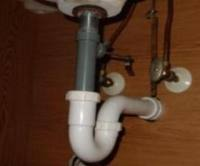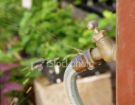 A plumbing leak at a sink trap can caused by several things. First, investigate the leak to make sure it is actually coming from the P-trap. You may find that the leak is coming from somewhere higher up than the trap and is just dripping from the trap since it is the lowest point on the drain piping. If you have determined the leak is from the trap, then you can unscrew the fittings on both ends of the trap and dump out the water into a bucket.
A plumbing leak at a sink trap can caused by several things. First, investigate the leak to make sure it is actually coming from the P-trap. You may find that the leak is coming from somewhere higher up than the trap and is just dripping from the trap since it is the lowest point on the drain piping. If you have determined the leak is from the trap, then you can unscrew the fittings on both ends of the trap and dump out the water into a bucket.
Inspect the trap for cracks, and look closely at the ends where it threads onto the joining piping. In many cases, the nut can be cross threaded and not properly sealed. This may be the case if the slip nut is very hard to unscrew and doesn’t unscrew smoothly. Screwing this slip nut carefully back on the pipe may fix it.
Also look at the washer to see if it is damaged. If it is split or damaged, it will allow water to pass and leak. Replacing this washer will fix the problem. By the way, you won’t need to use Teflon tape on the threads as these joints are not under pressure.
Obviously, if the P-trap is damaged or cracked, you will need to replace it.
 If you've noticed a tall, lush green patch of grass in your yard you may have a plumbing problem. Go over and step in the area and your foot will probably sink to your ankle. This grass is greener and more healthy than the surrounding grass because it is getting more water and/or nutrients. In other words, you probably have a pipe break underground.
If you've noticed a tall, lush green patch of grass in your yard you may have a plumbing problem. Go over and step in the area and your foot will probably sink to your ankle. This grass is greener and more healthy than the surrounding grass because it is getting more water and/or nutrients. In other words, you probably have a pipe break underground.
The leak may be occurring only when the irrigation system is on, or it may be leaking all the time. You can check your water meter for movement when all other house fixtures are off.
Grab your shovel and start digging in the area of the soft turf. It's probably going to be a lot like a marsh...soft and muddy. You will need to dig to a level where you find the problem. It may be close to the surface, it may not be. It helps to dig a little, turn on the irrigation, and watch for water rising out of the mud. At least then you'll know where to focus your digging efforts.
Once you find the broken pipe, you will need to dig around it so that you can work in the area. Keep the water off so the ground can absorb some of the water, and use a small cup will help you get the water out (tearing a fast food cup in half works well for this).
Inspect the pipe for damage. If you can't see obvious damage, you will have to turn on the irrigation briefly to find it. Let the area dry out and repair the break.
 If you've ever had a dripping hose faucet (aka a hose bib) handle , you know how frustrating it can be. You can turn the handle as hard as you can and yet it still won't stop leaking around the handle. This is true for washing machine hose faucets as well. Sure you could replace it, but try a quick repair first.
If you've ever had a dripping hose faucet (aka a hose bib) handle , you know how frustrating it can be. You can turn the handle as hard as you can and yet it still won't stop leaking around the handle. This is true for washing machine hose faucets as well. Sure you could replace it, but try a quick repair first.
The handle is attached to the faucet via a cap. This cap screws onto the hose faucet. The first thing I would try is to tighten this cap by a quarter-turn. This may stop the leak, but you may notice that it is harder to turn the faucet on-and-off. Personally, I can live with that.
Underneath this cap is the secret to no leaks: packing. Packing looks like a small rope made of Teflon, and it comes in a variety of diameters. You wrap this packing around the stem and as you tighten the cap back down everything compresses to seal out any leaks. If you add packing and it still leaks you can add a little more.
Had the faucet leaked at the spout (where water is supposed to run out), you could have tried to disassemble the faucet and replace a washer, or just replace the hose faucet.
 Recently I had a customer who had a plumbing line break and she needed to shut off the water to the house. She didn't know how. She was recently single and never had to worry about it. So this Las Vegas handyman walked her through it over the phone. Then it dawned on me that I'll bet there are a lot of people who don't know how to turn the water off during an emergency. So here goes.
Recently I had a customer who had a plumbing line break and she needed to shut off the water to the house. She didn't know how. She was recently single and never had to worry about it. So this Las Vegas handyman walked her through it over the phone. Then it dawned on me that I'll bet there are a lot of people who don't know how to turn the water off during an emergency. So here goes.
Most plumbing fixtures have water shut-off valves to isolate that fixture. For example, toilets and faucets will have a valve at the wall to shut off the water. Plastic piping, such as PEX, will have a manifold that will house all the shut off's in a small cabinet. You turn the water off with a small key. So if the toilet, for example, is running and you don't know what to do...well you can just reach over and turn off the valve. There is no urgency there.
However, if a pipe in a wall breaks then its time for some quick thinking. There will be main water shut-off outside, usually in front of the house at the sidewalk. Look for a cover at the sidewalk with a small hole in it. You can stick a screwdriver in this hole and pry or lift it off and push it aside (there are usually a lot of bugs down there so be prepared). In the hole you will see a meter with a clear covering so that you can read the numbers (it will probably be spinning like an airplane propeller due to the amount of water running). Connected to the meter is the shut-off valve. The proper tool to shut off this valve is a water key, which looks like a large letter "T". You put your hands on the top of the "T" and the bottom of the "T" has a slot which mates with the valve. If you don't have a water key don't worry, I shut them off all the time with a pair of pliers, or a crescent wrench and a screwdriver...whatever is closest to me. Turn the valve until the meter stops spinning.
This will shut off the water to the entire house, landscape included. Some homes have a separate valve built in that allows you to shut off the water to the house without shutting off the water to the landscape. If your house has one, you will typically find it in the garage about 2 feet from the floor.